

ALGIZ 10X improves order fulfillment at 150,000-square-meter warehouse
NAUTIZ X8 provides communication and navigation support for glacier explorer
Fast, discreet radiation monitoring — Inconspicuous NAUTIZ X8 makes it easy
Timber buyers increase accuracy, efficiency and profits with rugged handhelds
Algiz 10X emergency response system improves efficiency for ambulance workers
Nautiz X3 helps meat distribution company improve quality control in refrigerated storage facilities
Nautiz X8 helps GIS professionals calculate utility pole measurements
Great Lake Energy uses Algiz 7 computers used in SHESH project
Algiz 10X computers used in telemedicine case
Nautiz X4 computers improve logistics and cargo monitoring for a Scandinavian transport company
Handheld CEO: Rugged computers a game-changer in critical field rescue situations
Handheld CEO: Rugged Computing Key Trends in 2015
Handheld CEO: Rugged Computers Are More Than Just 'Hard Shells'
Handheld CEO: The Trend Towards 'Ruggedish' Computers and Smartphones
Technology for Technicians: 2013 Trends
Handheld CEO: How to Purchase Mobile Computers Wisely
Case Study: Computers in Diving and Marine Exploration
Handheld Group Business Partner Conference 2010, Stockholm
|

|

|
|
|
|
Case Study: Computers in Diving and Marine Exploration
Handheld Algiz XRW compact rugged notebook computer boosts safety, productivity, data capture on marine underwater expedition to remote archipelago
(by Conrad H. Blickenstorfer -- photography by Carol Cotton)
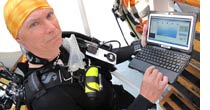 In June of 2011, editors of RuggedPCReview.com and ScubaDiverInfo.com traveled on the 112-foot Solmar V to the Archipelago Revillagigedo, a remote group of uninhabited islands 300 miles off the Pacific coast of Mexico, to test a variety of rugged and underwater equipment while surveying the status of the shark and giant manta populations these islands are famous for. Part of our test equipment arsenal was a rugged Handheld Group Algiz XRW notebook computer. It would become a valuable member of the team in more than one respect. In June of 2011, editors of RuggedPCReview.com and ScubaDiverInfo.com traveled on the 112-foot Solmar V to the Archipelago Revillagigedo, a remote group of uninhabited islands 300 miles off the Pacific coast of Mexico, to test a variety of rugged and underwater equipment while surveying the status of the shark and giant manta populations these islands are famous for. Part of our test equipment arsenal was a rugged Handheld Group Algiz XRW notebook computer. It would become a valuable member of the team in more than one respect.
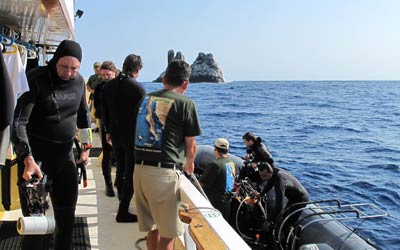 The volcanic 2.3 square mile island of San Benedicto, in particular, is famous for its prevalence of Giant Pacific Mantas. Manta rays (Manta birostris) are massive filter feeders that can reach a width of 25 feet and a weight of almost 3,000 pounds. Mantas are among the most majestic, graceful and elegant creatures on earth, and seeing them in their natural habitat is a breathtaking, awe-inspiring experience.
The volcanic 2.3 square mile island of San Benedicto, in particular, is famous for its prevalence of Giant Pacific Mantas. Manta rays (Manta birostris) are massive filter feeders that can reach a width of 25 feet and a weight of almost 3,000 pounds. Mantas are among the most majestic, graceful and elegant creatures on earth, and seeing them in their natural habitat is a breathtaking, awe-inspiring experience.
Despite their intimidating size and alien spacecraft look, giant mantas are gentle life forms of unusual intelligence. While taxonomically related to sharks, they are harmless to humans and only feed on plankton and krill. Mantas have a tail like other rays, but there is no stinger. Manta populations are threatened by fishing nets and by being directly hunted for their gills that certain cultures believe have medical properties. As strong believers in supporting marine conservation efforts, the authors are also members of the Manta Network, a 501.c.3 non-profit engaged in population studies, environmental education, environmental assessment studies and public awareness initiatives.

The pictures above and below, taken with by the team with Canon G10 and Canon Eos T2i cameras in deepwater housings, show some of the giant mantas we encountered at the Revillagigedo islands of San Benedicto and Socorro.

Computers in diving and marine exploration
Computers play several major roles in dive expeditions. Dive computers are crucial life support equipment for divers. Logs from dive computers are then uploaded into mobile computers for analysis and documentation. The mobile computers are also used for trip notes and narrative, image and video storage and pre-processing, as well as geotagging and navigation.
Scuba diving is an equipment-intensive activity where there is essentially no margin for error. When hovering off a wall a hundred feet below the ocean surface, you rely on your regulator to supply air, on your buoyancy compensator to keep you from dropping into the abyss below you and from rising too quickly and risking an air embolism or other life-threatening conditions. 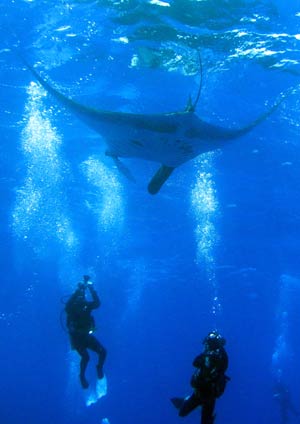 All scuba divers learn diving physics and how to use dive tables to determine maximum exposure to depth and allowable depths on repetitive dives. While dive tables remain important backups, today divers almost exclusively rely on dive computers. All scuba divers learn diving physics and how to use dive tables to determine maximum exposure to depth and allowable depths on repetitive dives. While dive tables remain important backups, today divers almost exclusively rely on dive computers.
Dive computers are either wrist or console-mounted and keep track of depth, dive time, water temperature, remaining bottom time, decompression stops, and remaining air. Due to the depth and intensity of the dives our dive team used an oxygen-enriched air mixture called Nitrox that reduces nitrogen loading and thus increases allowable bottom time as well as reducing fatigue. All used air-integrated dive computers that communicate directly with a transmitter attached to the regulator's first stage where it constantly reads remaining air pressure. This not only eliminates an air-hose that increases the danger of getting entangled, but also allows the dive computer to calculate remaining air time, exertion levels and current and average gas consumption.
Dive computers are complex instruments that must be 100% reliable as the diver's life can depend on it. Their batteries can last for many hundreds of dives. Depending on the computer, it uses one or more mathematical models to determine nitrogen on and off-gassing in a variety of tissue groups. This is because the human body consists of different tissues, some of which, like cartilage and bone, absorb nitrogen very slowly whereas others, like lung tissue, absorb and release nitrogen much more quickly. The mathematical models approximate the composition of the human body by tracking the absorption and expulsion of gas of a number of theoretical tissues.
This computed data, which changes with time stayed at different depths, determines how much remaining safe dive time a diver has, and what decompression stops must be made, if any. The image below is a screen capture of a typical dive computer companion software application, and shows one of our dives at Roca Partida, a stark twin rock that sits in the middle of nowhere approximately 85 miles west of San Benedicto:
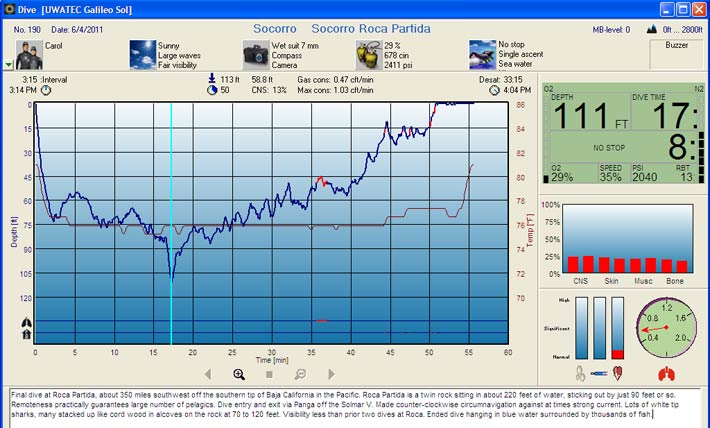
Dive computers have numerous configurable alarms and settings, and they usually work in conjunction with a desktop or notebook computer application. The dive computer also datalogs the entire dive so that it later can be uploaded into the notebook. In the past we had to wait until we got back to camp or our cabins to upload and analyze the dive data and fill out our dive logs. This often meant several hours between a dive and filling out the log. It also means not being able to visually inspect the dive profile, exertion levels, gas consumption, tissue saturation levels and alarms.
Using the Handheld XRW rugged notebook computer on the Solmar V
Using the Algiz XRW, a rugged notebook computer from the Handheld Group, as a dive and expedition support computer changed all that. We took it onboard the Solmar V and uploaded dive data as soon as we came out of the water using a USB-based IR adapter that communicated with our Uwatec SOL dive computers. This allowed us to enter data and impressions immediately after a dive when everything was still fresh in our minds and we remembered detail. It also allowed us to change dive computer settings and fine-tune them to the dives at hand. The picture below shows the author examining data after a dive.
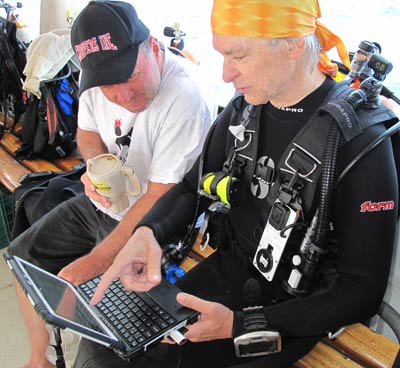 Using a computer on a boat means it needs a daylight-readable display. The Algiz XRW's very bright sunlight-readable high-res display is uniquely suited for outdoor use and work in direct sunlight. During our 8-day expedition we encountered anything from bright sunshine to gray skys and a good deal of wind and saltwater spray. The Algiz XRW display easily handled all lighting conditions and was perfectly viewable at all time. The readability of the display is, in fact, absolutely amazing, prevailing even against the blazing sun. Using a computer on a boat means it needs a daylight-readable display. The Algiz XRW's very bright sunlight-readable high-res display is uniquely suited for outdoor use and work in direct sunlight. During our 8-day expedition we encountered anything from bright sunshine to gray skys and a good deal of wind and saltwater spray. The Algiz XRW display easily handled all lighting conditions and was perfectly viewable at all time. The readability of the display is, in fact, absolutely amazing, prevailing even against the blazing sun.
While the covered dive deck of the Solmar V provided some protection from the elements, it was still outdoors and in the midst of wet and dripping dive equipment (and divers). Being used on the dive and observation decks also included exposure to surf, spray and the occasional wave washing over the front or sides.
This is where the Algiz XRW's IP65 sealing came in handy. It is not submersible, but the "5" in the rating means protection against low pressure water jets from all directions, so water spray on a dive boat won't hurt it. The sealed 90%-scale keyboard inspires confidence and is fully usable. The white on black letters are clearly visible at all times. Using the navigation pad with wet hands occasionally required a firmer touch, but it worked.
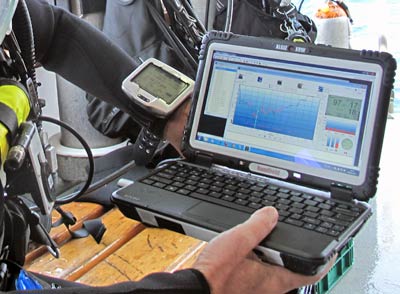 Space was at an absolute premium on the Solmar V and especially in our small cabins, and so we appreciated the XRW's compact size that made it fit where our much larger (and non-rugged) Apple MacBooks didn't. The XRW is also light enough not to add too much to the already considerable burden of hefting around scuba tanks and other bulky equipment. Also much appreciated was the XRW's long battery life. The beefy 58 watt-hour battery is good for eight hours of operation, more than enough to remain reliably available over the three or four dives our team usually did each day. Space was at an absolute premium on the Solmar V and especially in our small cabins, and so we appreciated the XRW's compact size that made it fit where our much larger (and non-rugged) Apple MacBooks didn't. The XRW is also light enough not to add too much to the already considerable burden of hefting around scuba tanks and other bulky equipment. Also much appreciated was the XRW's long battery life. The beefy 58 watt-hour battery is good for eight hours of operation, more than enough to remain reliably available over the three or four dives our team usually did each day.
I can't say enough for the peace of mind afforded by the Algiz XRW's ruggedness. Life on a dive deck is rough. It's wet, it's slippery, and there's lots of heavy equipment that can and will fall. Definitely not a place for MacBooks and iPads, but the Handheld Algiz XRW fit right in.
Few recreational divers upload their dive computer data into a notebook for analysis, even though this provides an important record of dives performed. For professional assignments, however, uploading and analyzing dive data is a must. Having a suitable mobile computing platform on location makes this task easier and allows uploading and analyzing right after dives. This can be invaluable. Theoretically, almost any notebook computer could be used for the job. In practice, size, ruggedness, outdoor-viewability and battery life requirements made the Algiz XRW perfect for the job.
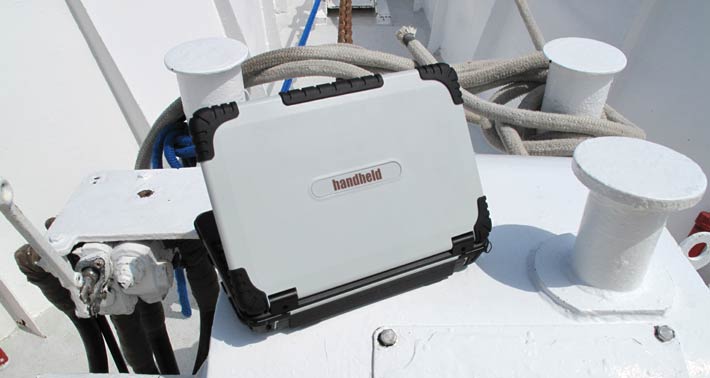
The Algiz XRW contibuted in other areas as well. Its high resolution display meant that the team used it to examine the hours of 720p and even 1080p video we took underwater. This wasn't possible with standard netbooks that we'd taken on earlier trips, but the XRW easily played back the video from our JVC and GoPro 1080p HD underwater cameras.
During the trip we also used the XRW's integrated GPS to determine our position, speed and heading. We installed free or demo versions of several marine navigation applications, including Polar Navy's PolarView navigation package and PolarCOM NMEA instrument display; the Sea Clear II chart plotter and GPS navigation software; and the Fugawi Marine ENC GPS navigation software. All worked well with the Algiz XRW and provided an interesting insight into the use of rugged sealed notebooks for marine navigation. Finding marine ENC or RNC charts for the Archipelago Revillagigedo was more difficult. For all US waters, NOAA and its Office of Coast Survey offer detailed free charts, but outside of their jurisdiction, you need to purchase commercial maps. The two screen snaps below show a PolarCOM position off the coast of San Benedicto (left) and a Sea Clear world view of the Solmar V's position on the 24-hour crossing from the southern tip of Baja California to the archipelago.

As far as the manta and other large pelagic populations go, the news was mixed. We did see a good number of giant mantas off San Benedicto and some off Socorro. We also saw dolphins, wahoos, tunas and several types of sharks (including a whale shark). 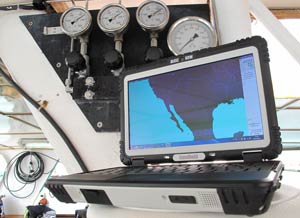 While the mantas were there in relative force, the shark count seemed down even in these remote waters. This may have been seasonal or due to weather conditions and visibility, or it may be due to illegal fishing and finning even in protected marine parks. While the mantas were there in relative force, the shark count seemed down even in these remote waters. This may have been seasonal or due to weather conditions and visibility, or it may be due to illegal fishing and finning even in protected marine parks.
Our equipment, though, worked flawlessly. Keeping track of our dives, storing and reviewing pictures and videos, and just generally having a computer whenever and wherever we needed it contributed to safety, productivity as well as staying on our busy schedule.
– Conrad H. Blickenstorfer, June 2011
FOR MORE INFO:
Handheld Group
Handheld US
SaveTheMantas.org
Algiz XRW
Solmar V
|
Handheld Algiz XRW Specifications
|
| Added/changed |
Added 07/2011
|
| Type |
Ultra-rugged notebook computer
|
| Processor |
Intel Atom Z550, 512KB L2 cache, 533MHz FSB |
| Processor speed |
2.00GHz |
| OS |
Windows 7 Ultimate |
| Chipset Controller |
Intel US15W with integrated graphics |
| Memory |
2GB DDR2 expandable |
| Display type |
Sunlight-readable 10.1-inch "MaxView" TFT with LED backlight |
| Display resolution |
WXGA 1366 x 768 pixel (720p) |
| Digitizer/Pens |
None on our review unit; per Handheld, touchscreen is now standard |
| Keyboard |
83-key 90%-scale, LED illumination |
| Storage |
64GB SSD |
| Expansion |
1 SD Card (SDXC-compliant) |
| Housing |
Plastic with protective rubber bumpers |
| Operating temperature |
-6 to 158 degrees Fahrenheit (-21 to 70 degrees centigrade) |
| Vibration/Drops |
MIL-STD-810F, Method 514.5 Procedures I & II, General minimum integrity and the more rigorous loose cargo test
|
| Enclosure Class |
IP65 |
| Hazardous materials |
unknown |
| Size |
10.2 x 7.0 x 1.6 inches (260 x 178 x 40 mm) |
| Weight |
3.3 pounds (1.5 kg)
|
| Power |
Li-Polymer 11.6V, 4,800 mAh, 57.6 watt-hours, "8 hours"
|
| Communication |
802.11b/g/n, Bluetooth 2.0 + EDR, u-Blox GPS, optional: WWAN (HSDPA/3G, Wimax, GOBI2000)
|
| Interface
|
2 USB 2.0, 1 RS232 DB9, 1 VGA, dock, audio in/out, docking connector, stereo speakers, 2mp camera with auto focus
|
Price |
Starts at US$2,700 |
| Contact |
Handheld Group www.handheldgroup.com |
|
|
|




 In June of 2011, editors of RuggedPCReview.com and ScubaDiverInfo.com traveled on the 112-foot Solmar V to the Archipelago Revillagigedo, a remote group of uninhabited islands 300 miles off the Pacific coast of Mexico, to test a variety of rugged and underwater equipment while surveying the status of the shark and giant manta populations these islands are famous for. Part of our test equipment arsenal was a rugged Handheld Group Algiz XRW notebook computer. It would become a valuable member of the team in more than one respect.
In June of 2011, editors of RuggedPCReview.com and ScubaDiverInfo.com traveled on the 112-foot Solmar V to the Archipelago Revillagigedo, a remote group of uninhabited islands 300 miles off the Pacific coast of Mexico, to test a variety of rugged and underwater equipment while surveying the status of the shark and giant manta populations these islands are famous for. Part of our test equipment arsenal was a rugged Handheld Group Algiz XRW notebook computer. It would become a valuable member of the team in more than one respect.
 The volcanic 2.3 square mile island of San Benedicto, in particular, is famous for its prevalence of Giant Pacific Mantas. Manta rays (Manta birostris) are massive filter feeders that can reach a width of 25 feet and a weight of almost 3,000 pounds. Mantas are among the most majestic, graceful and elegant creatures on earth, and seeing them in their natural habitat is a breathtaking, awe-inspiring experience.
The volcanic 2.3 square mile island of San Benedicto, in particular, is famous for its prevalence of Giant Pacific Mantas. Manta rays (Manta birostris) are massive filter feeders that can reach a width of 25 feet and a weight of almost 3,000 pounds. Mantas are among the most majestic, graceful and elegant creatures on earth, and seeing them in their natural habitat is a breathtaking, awe-inspiring experience.


 All scuba divers learn diving physics and how to use dive tables to determine maximum exposure to depth and allowable depths on repetitive dives. While dive tables remain important backups, today divers almost exclusively rely on dive computers.
All scuba divers learn diving physics and how to use dive tables to determine maximum exposure to depth and allowable depths on repetitive dives. While dive tables remain important backups, today divers almost exclusively rely on dive computers.

 Using a computer on a boat means it needs a daylight-readable display. The Algiz XRW's very bright sunlight-readable high-res display is uniquely suited for outdoor use and work in direct sunlight. During our 8-day expedition we encountered anything from bright sunshine to gray skys and a good deal of wind and saltwater spray. The Algiz XRW display easily handled all lighting conditions and was perfectly viewable at all time. The readability of the display is, in fact, absolutely amazing, prevailing even against the blazing sun.
Using a computer on a boat means it needs a daylight-readable display. The Algiz XRW's very bright sunlight-readable high-res display is uniquely suited for outdoor use and work in direct sunlight. During our 8-day expedition we encountered anything from bright sunshine to gray skys and a good deal of wind and saltwater spray. The Algiz XRW display easily handled all lighting conditions and was perfectly viewable at all time. The readability of the display is, in fact, absolutely amazing, prevailing even against the blazing sun.
 Space was at an absolute premium on the Solmar V and especially in our small cabins, and so we appreciated the XRW's compact size that made it fit where our much larger (and non-rugged) Apple MacBooks didn't. The XRW is also light enough not to add too much to the already considerable burden of hefting around scuba tanks and other bulky equipment. Also much appreciated was the XRW's long battery life. The beefy 58 watt-hour battery is good for eight hours of operation, more than enough to remain reliably available over the three or four dives our team usually did each day.
Space was at an absolute premium on the Solmar V and especially in our small cabins, and so we appreciated the XRW's compact size that made it fit where our much larger (and non-rugged) Apple MacBooks didn't. The XRW is also light enough not to add too much to the already considerable burden of hefting around scuba tanks and other bulky equipment. Also much appreciated was the XRW's long battery life. The beefy 58 watt-hour battery is good for eight hours of operation, more than enough to remain reliably available over the three or four dives our team usually did each day.


 While the mantas were there in relative force, the shark count seemed down even in these remote waters. This may have been seasonal or due to weather conditions and visibility, or it may be due to illegal fishing and finning even in protected marine parks.
While the mantas were there in relative force, the shark count seemed down even in these remote waters. This may have been seasonal or due to weather conditions and visibility, or it may be due to illegal fishing and finning even in protected marine parks.